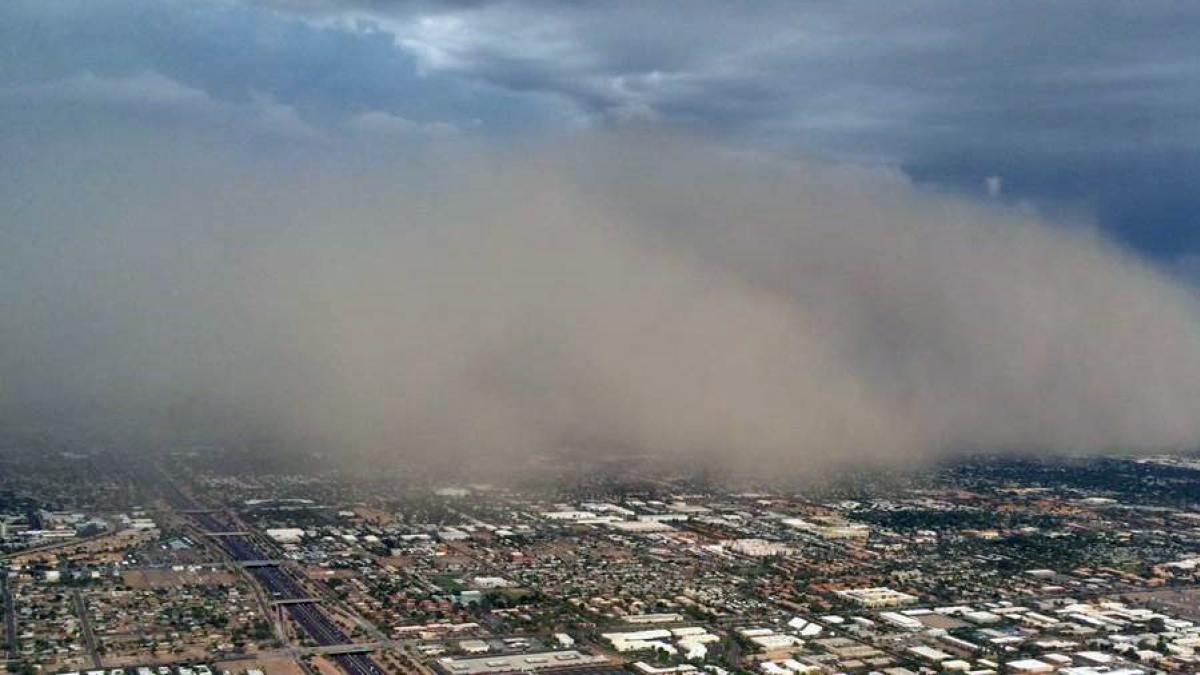ASU researchers to address local air-quality concerns

Air quality is affected by dust moving across the Valley.
Air quality is acknowledged as a critically important influence on public health. In the Valley of the Sun, air-quality issues related to dust, ozone and microorganisms are of particular concern.
Arizona State University researchers Pierre Herckes, from the School of Molecular Sciences, and Matt Fraser, from the School of Sustainable Engineering and the Built EnvironmentThe School of Sustainable Engineering and the Built Environment is one of the seven schools in the Ira A. Fulton Schools of Engineering., have received funding from the Arizona Board of Regents to investigate the sources of local air pollution and ways to ameliorate their influence and to improve the air we breathe.
Herckes and Fraser will work with other researchers from Northern Arizona University, the University of Arizona and the Arizona Department of Environmental Quality to study airborne pollutants that can cause respiratory and other health problems.
Herckes will bring his expertise in environmental chemical analysis to measure potentially harmful airborne species and identify their sources, including ozone, dust and microorganisms. Of particular interest to Herckes is the fungus that occurs naturally in soil throughout the Southwest that is responsible for Valley fever.
Fungal spores become airborne when wind or humans disturb the soil and, when inhaled, can infect the lungs. With an increasing number of cases, over 20,000 in the past year alone, Valley fever is a significant health concern. However, very little is known about where the fungus occurs and how the spores become airborne.
“Right now, we understand very little about the distribution of the fungus that causes Valley fever, what conditions are needed to get the spores airborne and how far they can travel,” noted Herckes. “We will take air samples from multiple locations throughout the year to determine how many of these spores are in the air, where they are distributed and how frequently.”
MORE: Valley Fever Collaborative awarded $3M in research funds
Another important contributing factor to local air quality is how much dust is in the air. The entrainment of dust, whether by wind, farming or road construction, adds to the amount of dust we breathe.
“When you look at construction areas and fields that have been recently tilled, there is a lot of loose material that can get kicked up into the air," Herckes said. "During the monsoon season, or when haboobs occur any time of the year, loose particles are picked up and carried towards the city. To address this, we are looking at ways to stabilize soils and reduce the amount of dust in the air.”
To do this, the team will apply environmentally friendly stabilizers to the soil and measure changes in the amount of dust that gets carried aloft by the wind. If successful, these stabilizers can be used in construction sites or fields to reduce dust pollution, a clear benefit to those who suffer from respiratory conditions.
Respiratory problems can also be exacerbated by high levels of ozone. Ozone is a molecule related to oxygen in atomic composition, but it is much more chemically reactive. Ozone has the ability to damage the surfaces of many materials it comes into contact with by chemical oxidation, whether metals, rubber tires or biological membranes, such as those in the lungs. Consequently, high ozone levels can play a role in triggering asthma or intensifying other respiratory ailments.
“Ozone is a major component of photochemical smog,” Herckes said. “We can measure ozone easily, but there are other oxidant species that co-occur with ozone, some of which are also very reactive and can cause irritation. We will need to measure volatile organic compound (VOC) fluxes from plants, which is very complicated.”
Herckes’ research group is accustomed to tackling challenging environmental problems, whether developing measurement methods, characterizing human exposure or identifying sources of pollution. In previous research, the Herckes group was able to identify sources of air-quality violations in Pinal County so that local agencies could formulate and implement remediation plans.
Herckes’ team also leads ASU’s research on a different public health issue — that of mask quality and the effects of sterilization on mask effectiveness in response the COVID-19 pandemic. They also analyzed air quality during the pandemic to assess how the lockdown affected local air pollution.
“The ASU Charter challenges us to advance research of public value and assume responsibility for the social and overall health of our local community," said Tijana Rajh, director of the School of Molecular Sciences. "The work that Herckes and his group are doing rises to that challenge and advances the school’s mission of building societal-based research programs."
More Science and technology

Stuck at the airport and we love it #not
Airports don’t bring out the best in people.Ten years ago, Ashwin Rajadesingan was traveling and had that thought. Today, he is…

ASU in position to accelerate collaboration between space, semiconductor industries
More than 200 academic, business and government leaders in the space industry converged in Tempe March 19–20 for the third annual…

A spectacular celestial event: Nova explosion in Northern Crown constellation expected within 18 months
Within the next year to 18 months, stargazers around the world will witness a dazzling celestial event as a “new” star appears in…

